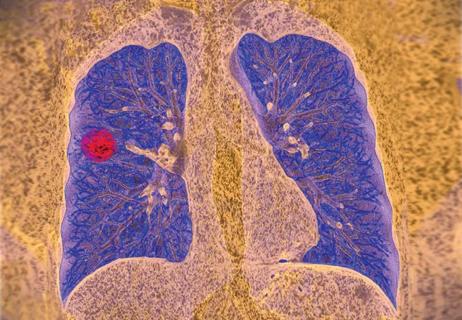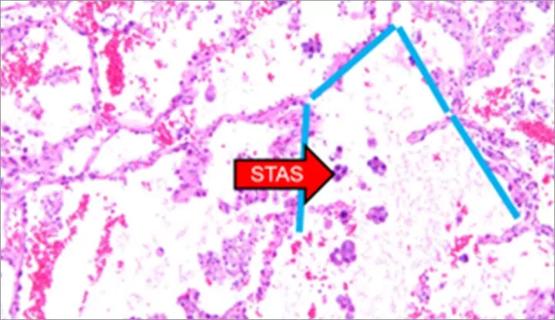Cleveland Clinic, the University of Minnesota and University of Cambridge receive $1M grant to develop point-of-care biosensor for early detection and treatment personalization

Currently, oncologists order circulating tumor (ctDNA) tests to determine the appropriate treatment for patients with non-small cell lung cancer (NSCLC). However, this process can take several weeks to get the results. Additionally, the high cost of current testing instrumentation is a barrier, which results in many patients not having access to this crucial test.
Advertisement
Cleveland Clinic is a non-profit academic medical center. Advertising on our site helps support our mission. We do not endorse non-Cleveland Clinic products or services. Policy
To address this shortcoming, researchers at Cleveland Clinic Cancer Institute, the University of Cambridge and the University of Minnesota are collaborating on the development of a photonic sensor that could revolutionize the way these tests are performed.
Director of Cleveland Clinic’s Novel Cancer Therapeutics Center Wen Wee Ma, MBBS, Associate Professor Michael Crisp, PhD, and Professor Richard Penty, PhD, both of the University of Cambridge, and Distinguished McKnight University Professor Tianhong Cui, PhD, of the University of Minnesota were awarded a $1M research grant from the U.S. National Science Foundation and the U.K. Engineering and Physical Science Research Council for this endeavor.
The research team plans to create a highly sensitive, low-cost biosensor that is small enough to be used in an oncologist’s office. The goal is to deliver rapid results and increase testing access.
ctDNA may be used in the diagnosis of early-stage lung cancer. Additionally, identifying somatic genetic alterations in ctDNA allows for the molecular characterization of NSCLC tumors. This information is essential for oncologists in determining the right therapy.
Currently, ctDNA testing requires shipping a blood sample either to a clinic's lab or to a commercial vendor. Once the blood sample arrives, the lab performs PCR-based testing, which involves using a biochemical reaction to amplify the circulating tumor DNA. Extracting and amplifying the DNA requires costly infrastructure, and the complexity contributes to the longer turnaround time. Additionally, the chemical reactions are prone to variables and contamination that may impact test results.
Advertisement
As an early phase therapeutics specialist, Dr. Ma has an interest in new ideas that increase patient convenience and access. Engineering specialist Dr. Cui has a track record of miniaturizing and manufacturing biosensor devices. Together, Drs. Cui and Ma conceptualized how they could apply this technology to create a portable tool that would increase access to screening and diagnostics.
They teamed up with University of Cambridge researchers with expertise in photonics. “Photonics is at the stage where you can maneuver lasers for small molecules detection instead of relying on biochemical reactions,” explains Dr. Ma. “Nanofabrication enables the production of portal devices designed to overcome the challenges of complex conditions needed for biochemical reactions. This technique can directly contribute to the precision needed for ctDNA detection.”
The prototype the team develops will combine microwave photonics and polymer-based micro-ring resonator technology to replace the cumbersome instrumentation currently needed for performing ctDNA testing. Once the prototype is built, the vision is to develop it into a clinical platform to detect ctDNA, which is key to personalized treatment for patients with lung cancer. The next step will be to potentially use the device as part of lung cancer screening.
“This partnership shows how new ideas can form when we bring together leaders in disparate fields to problem-solve important clinical care questions,” says Dr. Ma.
The University of Minnesota will lead nano imprint fabrication and microfluidics while the University of Cambridge will focus on microwave photonics, polymer waveguides and optical integration. The universities will work together to produce the prototype for clinical development in the Cleveland Clinic system. Throughout the project, Cleveland Clinic will serve as a clinical partner, guiding the development of the sensor.
Advertisement
The resulting technology has the potential to vastly improve patient access to this crucial testing.
Advertisement
Advertisement

Treatment assigned FDA review date in June 2025

Hybrid treatment model helps improve cancer care access

Resection, radiotherapy or ablation?

Extent of baseline burden impacts progression-free and overall survival

Quantum computing being studied as a means to help improve predictive performance, accuracy

Young age, solid tumor, high uptake on PET and KRAS mutation signal risk, suggest need for lobectomy

Targeting DNMT1 shows promise in chemotherapy- and immunotherapy-resistant SCLC

New review published in Cancers suggests a synergistic benefit